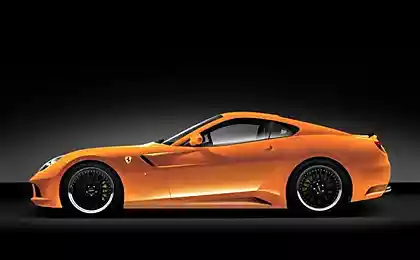2790
But this suit can try?
Breaking the air at the speed of sound and rush to the horizon, stretching his arms at his sides in his iron suit. In no time be anywhere in the world without having to stand in a traffic jam. To fly without wings without being on board the aircraft or something stronger. Let me throw a stone who would not be in place of Tony Stark in his stellar moments (of course, in a suit of Iron Man). Some of these dreams will be able to realize the exoskeleton - a device that can increase a person's ability (mostly physical, muscular strength) due to the external frame. That is a device which developments are already available and how the technology will evolve in the future, we will describe in this article.
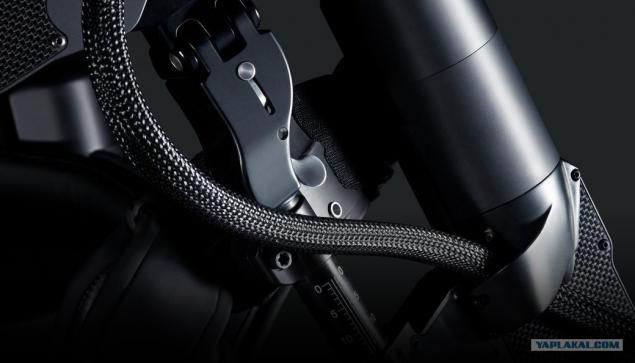
Science and technology - it's literally the most fierce race of the ingenuity of man and nature. Throughout its history the man trying to change the world around them to fit their needs. Somewhere he manages it, often without harming nature. Somewhere have to pry her. And if the majority of invertebrates in one form or another have an external skeleton, humans do not. But it was not, and wings?
Nowadays, under the implied mechanical exoskeleton suit or part thereof up to 2-2, 5 meters high. Then there are "mobile suits", furs and other giant humanoid robots.
Like many other things in our lives, exoskeletons gradually step over the boundary separating wildest dreams and daily life. Originally just ideas, concepts, myths and legends of science fiction, today almost every week there are new versions of exoskeletons.
First inventor of the exoskeleton is considered Russian "inzhener-mehanik" Nicholas Ferdinandovich Yagn that back in the 1890s, has registered a number of patents on the subject. He lived in America, where, in fact, patented his miracles, show them at exhibitions, and on his return to his native land again invent. His exoskeleton was to facilitate walking, running and jumping in the first place, the soldiers. Even then, the Russian genius foresaw the potential military power of these devices.
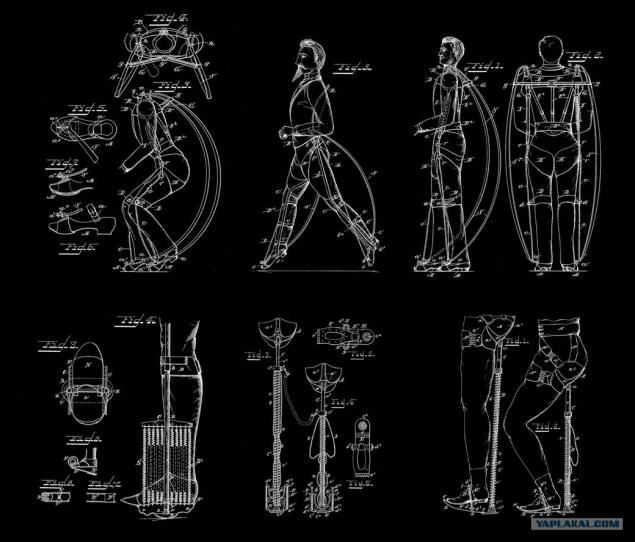
Hardiman
We will not deny gigantic and immense contribution to the development of science fiction have exoskeletons. In 1959, after the acclaimed novel by Robert A. Heinlein, "Starship Troopers" it became clear that for the external skeletal costumes - the future of warfare and not only. And away we go.
The first exoskeleton was created by General Electric, with the support of the Ministry of Defense in the 1960s. Hardiman weighed 680 pounds and could lift loads weighing up to 110 kilograms. With all the huge ambitions - and wanted to use it, and under water, and in space, and carry warheads and nuclear rods - he showed himself not the best way. About him safely forgotten.
Exoskeletons device remotely resembling "pedomotor" inventor Leslie S. Kelly, developed in 1917
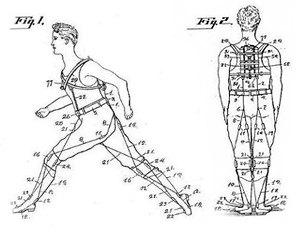
Nine years later Miomir Vukobratović of Yugoslavia in Belgrade showed first power walking exoskeleton, whose task was to give people with paraplegic opportunity to walk. At the core of the device lying actuator. Soviet scientists of the Central Institute of Traumatology and Orthopedics Priorov showed the first initiative to develop exoskeletons together with Yugoslav counterparts on the basis of the work is Vukobratovic. But with the beginning of the restructuring projects were closed, and a secret underground workings exoskeletons no data. But with the conquest of space, all was well.
At different times in different countries craftsmen tried to make exoskeletons of different purposes, but for a variety of obstacles (which we'll talk) it was possible to the edge of the poor. Lack of energy, the slow growth of scientific and technical progress, the development of materials science and other related sciences, as well as the development of computing and cybernetics, a wave which rose only 30 years ago - all it inhibited the development of exoskeletons. Without a doubt, this is a complex technology that people have yet to learn.
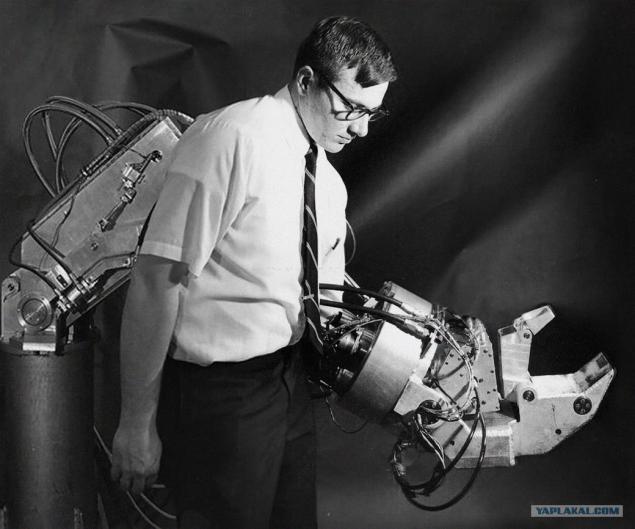
Problems exoskeletons
On this planet, not so much of the materials from which to make a hard skeleton and which do not aggravate the matter their weight. Anyway, there were not a lot, but with the space flight, military developments, development of materials science, nanotechnology, and even a dozen other interesting areas of humanity gradually picks up one barrier after another. At the beginning of the XXI century interest in the exoskeletons erupted with remarkable strength and stays still. But first, let's talk about the main problems faced by the creators of the exoskeletons.
If we expand the hypothetical exoskeleton into components, we will have: power supply, mechanical skeleton and software. And if the last two paragraphs seem to be all clear and the problem is almost gone, the power supply - it's a serious problem. With normal power supply, engineers could not just create an exoskeleton, and more and combine it with a suit and jetpack. Would have received the Iron Man suit, probably, but the new Tony Stark has not yet appeared.
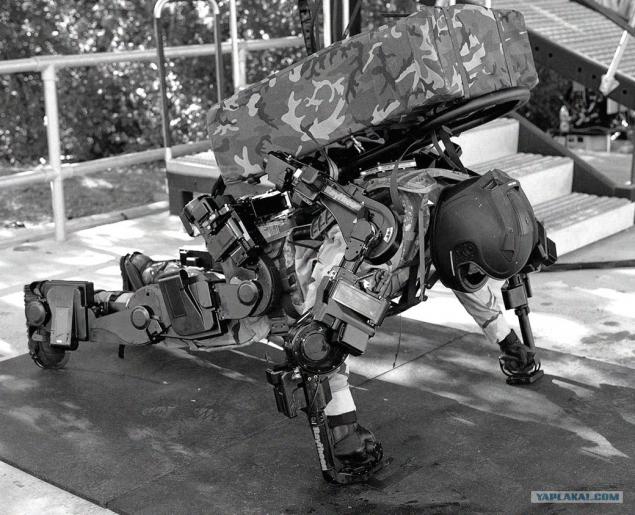
Food
Any of compact power sources today exoskeleton can provide a few hours of battery life. Next - the dependence on the wire. A non-rechargeable and rechargeable batteries have their limitations like the need to replace or slow charging, respectively. Internal combustion engines to be too reliable, but is not particularly compact. Besides, in the latter case need additional cooling system, and the internal combustion engine is difficult to configure for instant release of large amounts of energy. Electrochemical fuel cells can rapidly fill up with liquid fuel (e.g., methanol) to give the desired and instantaneous release of energy, but operate at very high temperatures. 600 degrees Celsius - a relatively low temperature for such power source. With him "Iron Man" will turn into a hot dog.
Ironically, the most feasible option for solving the issue of the fuel of the future exoskeletons can become the most impossible: wireless transmission of energy. It could solve a lot of issues, because it can be transmitted from an arbitrarily large reactor (nuclear and including). But how? The question is open.

Frame
First exoskeletons made of aluminum and steel, inexpensive and easy to use. But it became too heavy, and the exoskeleton must work hard to raise their own weight. Accordingly, when a large weight suit its efficiency drops. Aluminum alloys are light enough, but accumulate fatigue and, therefore, are not particularly suitable for high loads. Engineers are in search of light and strong materials like titanium or carbon fiber. They will inevitably be expensive, but will provide the efficiency of the exoskeleton.
A special problem is the drive. Standard hydraulic cylinders are sufficiently powerful and can operate with high accuracy, but require a heavy and a heap of hoses and tubes. Pneumatics, by contrast, is too unpredictable in terms of handling traffic as compressed gas springs, and reactive forces will push the drives.
However, the development of new electronic actuator on the basis of who will use the magnets and provide a responsive motion, consuming a minimum of energy and being small. Can you compare it with the transition from steam locomotives to trains. Note also the flexibility that should be at the joints, but this problem can be solved developers exoskeleton suits. They also help to understand adaptation to suit the size of the carrier.
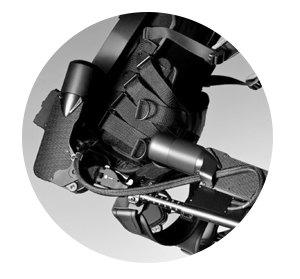
Manage
A particular problem is the creation of the exoskeleton control and adjustment of excessive and unwanted movements. You can not just take and make an exoskeleton with a reaction rate of each of the members. Such a mechanism may be too fast for the user, but it is not too slow to do - is ineffective. On the other hand, one can not rely on the user to trust the sensor reads the intentions body movements: movements of the user and desync costume will lead to injury. We need to limit both current directions. To resolve this issue and engineers scratching their heads. In addition, the need to advance to detect unintended or unwanted movement to sneeze or cough casual did not lead to call an ambulance.
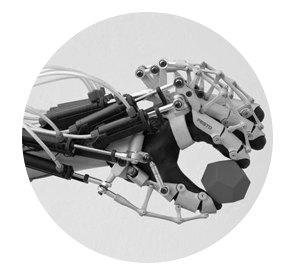
Exoskeletons and future
In 2010, the company Raytheon Sarcos and together with the Ministry of Defense showed combat exoskeleton XOS 2. The first prototype came out two years before that, but did not cause a stir. But XOS 2 was so steep that Time magazine included exoskeletons to list the top five military innovations of the year. Since then, the world's leading engineers are scratching their heads over the creation of exoskeletons that can provide an advantage on the battlefield. And outside of it too.

What do we have today?
ReWalk
This exoskeleton was introduced in 2011 and was designed for people with disabilities. In January 2013, published an updated version - ReWalk Rehabilitation, and in June 2014, the FDA approved the use of the exoskeleton in public and at home, thereby opening the way for him commercially. The system weighs about 23 kilos 3, runs on Windows, and in three modes: walk, sit and stand. Prices: from 70 to 85 thousand dollars.
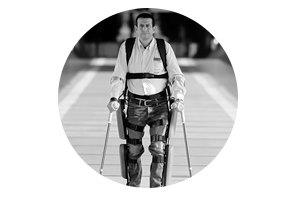
XOS
A series of military exoskeletons is in active development (XOS on turn 3). Weighs about 80 kilograms and allows the wearer to easily lift the 90 extra pounds. Latest model of costume so mobile that lets you play with a ball. As the producer, one XOS can replace the three soldiers. Perhaps a third generation exoskeleton will already closer to what we see on the screens fiction films of recent years. Alas, while it is attached to an external power source.
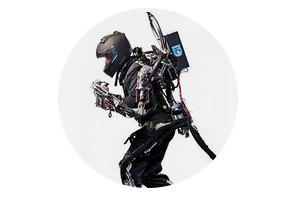
HULC
Human Universal Load Carrier - creature known company Lockheed Martin in conjunction with Berkeley Bionics. This exoskeleton is also designed for the military. Basis - hydraulics and lithium-polymer batteries. Correctly load an external skeleton, with its help the user can carry up to 140 pounds of excess cargo. It is assumed that the soldiers will be able to use the HULC a la "I iDMG" within 72 hours. The development is in full swing, so no wonder that HULC may first enter service USA.

ExoHiker, ExoClimber and eLEGS (Ekso)
Prototypes again Berkeley Bionics, designed to perform various tasks. The first is to help travelers to carry cargo up to 50 kilograms, was introduced in February 2005 and weighs about 10 kilograms. Given the small solar panel can work very, very long time. ExoClimber - it desyatikilogrammovoe addition to ExoHiker, allowing the wearer to jump and climb the stairs. In 2010, Berkeley Bionics developments resulted in eLEGS. This system - full hydraulic exoskeleton that allows paralyzed people walk and stand. In 2011, it was renamed in eLEGS Ekso. It weighs 20 kilograms, moves at a maximum speed of 3, 2 km / h and running for 6 hours.

HAL
Another sensational Japanese manufacturer exoskeleton robot Cyberdyne. Its purpose - to provide the opportunity to go to people with disabilities. There are two main options: HAL-3 and HAL-5. Since its presentation in 2011, less than a year, HAL took "adopt" more than 130 medical institutions nationwide. However, the tests will continue throughout 2014 and possibly 2015. In August 2013 HAL received carte blanche to use as a medical robot in Europe. The newest model of costume weighs about 10 kilograms.
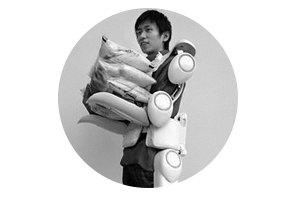
The average cost of medical exoskeleton -90,000 dollars.
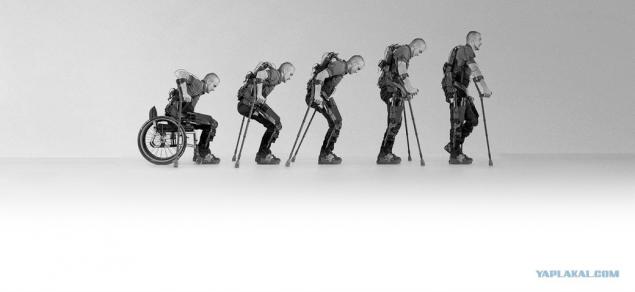
In addition to serious exoskeletons all over the body, more and more popular are limited exoskeletons designed to perform specific tasks. For example, in August this year was shown ekzostul Chairless Chair, allowing sit standing. Daewoo Company and Lockheed Martin independently showed exoskeletons for workers shipyards. These devices allow workers to retain the goods or tools weighing up to 30 kilograms, especially without straining.
In Russia, the development of the exoskeleton called "EkzoAtlet" engaged a team of scientists gathered at the base of the Institute of Mechanics, Moscow State University. They go back in the USSR started developing Vukobratovic, which we mentioned above. The first working passive exoskeleton of this team has been developed for emergency workers, firefighters and rescuers. Weighing in at 12 kilograms design allows effortless transfer of up to 100 kilograms of cargo. The company plans - development of power models ExoAtler-A, which will allow to carry up to 200 pounds, as well as medical exoskeleton for rehabilitation of people with disabilities.
Combines all of these suits is that they are presented mostly as prototypes. So will improve. Hence, they are waiting for field testing. So will the new models. Hence, they are the future. While talking about the fact that the working and useful exoskeleton can go out and buy on the black market early. But a start and development of this area is surely among the wide track. Prior to suit Tony Stark we still far away, but what prevents rejoice entertaining movie? Lovers spectacular showdown with exoskeletons will always be something to see: "Strangers" (1986), "Iron Man" (2008), "Avatar" (2009), "District number 9" (2009), "The Avengers" (2012), " Elysium "(2013)," All You Need Is Kill "(2014).
One thing is certain: exoskeletons in the future will be everywhere. They help our astronauts learn Mars, build the first colony and comfortably operated in space. They will be adopted in the military segment, since the default endow soldiers superhuman strength. They will give the opportunity to fully move to those who lost it. Iron Man suit one day become real as anything that you see around.
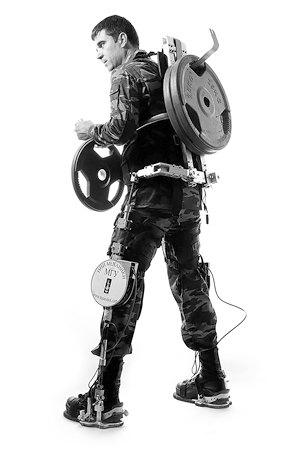

Science and technology - it's literally the most fierce race of the ingenuity of man and nature. Throughout its history the man trying to change the world around them to fit their needs. Somewhere he manages it, often without harming nature. Somewhere have to pry her. And if the majority of invertebrates in one form or another have an external skeleton, humans do not. But it was not, and wings?
Nowadays, under the implied mechanical exoskeleton suit or part thereof up to 2-2, 5 meters high. Then there are "mobile suits", furs and other giant humanoid robots.
Like many other things in our lives, exoskeletons gradually step over the boundary separating wildest dreams and daily life. Originally just ideas, concepts, myths and legends of science fiction, today almost every week there are new versions of exoskeletons.
First inventor of the exoskeleton is considered Russian "inzhener-mehanik" Nicholas Ferdinandovich Yagn that back in the 1890s, has registered a number of patents on the subject. He lived in America, where, in fact, patented his miracles, show them at exhibitions, and on his return to his native land again invent. His exoskeleton was to facilitate walking, running and jumping in the first place, the soldiers. Even then, the Russian genius foresaw the potential military power of these devices.

Hardiman
We will not deny gigantic and immense contribution to the development of science fiction have exoskeletons. In 1959, after the acclaimed novel by Robert A. Heinlein, "Starship Troopers" it became clear that for the external skeletal costumes - the future of warfare and not only. And away we go.
The first exoskeleton was created by General Electric, with the support of the Ministry of Defense in the 1960s. Hardiman weighed 680 pounds and could lift loads weighing up to 110 kilograms. With all the huge ambitions - and wanted to use it, and under water, and in space, and carry warheads and nuclear rods - he showed himself not the best way. About him safely forgotten.
Exoskeletons device remotely resembling "pedomotor" inventor Leslie S. Kelly, developed in 1917

Nine years later Miomir Vukobratović of Yugoslavia in Belgrade showed first power walking exoskeleton, whose task was to give people with paraplegic opportunity to walk. At the core of the device lying actuator. Soviet scientists of the Central Institute of Traumatology and Orthopedics Priorov showed the first initiative to develop exoskeletons together with Yugoslav counterparts on the basis of the work is Vukobratovic. But with the beginning of the restructuring projects were closed, and a secret underground workings exoskeletons no data. But with the conquest of space, all was well.
At different times in different countries craftsmen tried to make exoskeletons of different purposes, but for a variety of obstacles (which we'll talk) it was possible to the edge of the poor. Lack of energy, the slow growth of scientific and technical progress, the development of materials science and other related sciences, as well as the development of computing and cybernetics, a wave which rose only 30 years ago - all it inhibited the development of exoskeletons. Without a doubt, this is a complex technology that people have yet to learn.

Problems exoskeletons
On this planet, not so much of the materials from which to make a hard skeleton and which do not aggravate the matter their weight. Anyway, there were not a lot, but with the space flight, military developments, development of materials science, nanotechnology, and even a dozen other interesting areas of humanity gradually picks up one barrier after another. At the beginning of the XXI century interest in the exoskeletons erupted with remarkable strength and stays still. But first, let's talk about the main problems faced by the creators of the exoskeletons.
If we expand the hypothetical exoskeleton into components, we will have: power supply, mechanical skeleton and software. And if the last two paragraphs seem to be all clear and the problem is almost gone, the power supply - it's a serious problem. With normal power supply, engineers could not just create an exoskeleton, and more and combine it with a suit and jetpack. Would have received the Iron Man suit, probably, but the new Tony Stark has not yet appeared.

Food
Any of compact power sources today exoskeleton can provide a few hours of battery life. Next - the dependence on the wire. A non-rechargeable and rechargeable batteries have their limitations like the need to replace or slow charging, respectively. Internal combustion engines to be too reliable, but is not particularly compact. Besides, in the latter case need additional cooling system, and the internal combustion engine is difficult to configure for instant release of large amounts of energy. Electrochemical fuel cells can rapidly fill up with liquid fuel (e.g., methanol) to give the desired and instantaneous release of energy, but operate at very high temperatures. 600 degrees Celsius - a relatively low temperature for such power source. With him "Iron Man" will turn into a hot dog.
Ironically, the most feasible option for solving the issue of the fuel of the future exoskeletons can become the most impossible: wireless transmission of energy. It could solve a lot of issues, because it can be transmitted from an arbitrarily large reactor (nuclear and including). But how? The question is open.

Frame
First exoskeletons made of aluminum and steel, inexpensive and easy to use. But it became too heavy, and the exoskeleton must work hard to raise their own weight. Accordingly, when a large weight suit its efficiency drops. Aluminum alloys are light enough, but accumulate fatigue and, therefore, are not particularly suitable for high loads. Engineers are in search of light and strong materials like titanium or carbon fiber. They will inevitably be expensive, but will provide the efficiency of the exoskeleton.
A special problem is the drive. Standard hydraulic cylinders are sufficiently powerful and can operate with high accuracy, but require a heavy and a heap of hoses and tubes. Pneumatics, by contrast, is too unpredictable in terms of handling traffic as compressed gas springs, and reactive forces will push the drives.
However, the development of new electronic actuator on the basis of who will use the magnets and provide a responsive motion, consuming a minimum of energy and being small. Can you compare it with the transition from steam locomotives to trains. Note also the flexibility that should be at the joints, but this problem can be solved developers exoskeleton suits. They also help to understand adaptation to suit the size of the carrier.

Manage
A particular problem is the creation of the exoskeleton control and adjustment of excessive and unwanted movements. You can not just take and make an exoskeleton with a reaction rate of each of the members. Such a mechanism may be too fast for the user, but it is not too slow to do - is ineffective. On the other hand, one can not rely on the user to trust the sensor reads the intentions body movements: movements of the user and desync costume will lead to injury. We need to limit both current directions. To resolve this issue and engineers scratching their heads. In addition, the need to advance to detect unintended or unwanted movement to sneeze or cough casual did not lead to call an ambulance.

Exoskeletons and future
In 2010, the company Raytheon Sarcos and together with the Ministry of Defense showed combat exoskeleton XOS 2. The first prototype came out two years before that, but did not cause a stir. But XOS 2 was so steep that Time magazine included exoskeletons to list the top five military innovations of the year. Since then, the world's leading engineers are scratching their heads over the creation of exoskeletons that can provide an advantage on the battlefield. And outside of it too.

What do we have today?
ReWalk
This exoskeleton was introduced in 2011 and was designed for people with disabilities. In January 2013, published an updated version - ReWalk Rehabilitation, and in June 2014, the FDA approved the use of the exoskeleton in public and at home, thereby opening the way for him commercially. The system weighs about 23 kilos 3, runs on Windows, and in three modes: walk, sit and stand. Prices: from 70 to 85 thousand dollars.

XOS
A series of military exoskeletons is in active development (XOS on turn 3). Weighs about 80 kilograms and allows the wearer to easily lift the 90 extra pounds. Latest model of costume so mobile that lets you play with a ball. As the producer, one XOS can replace the three soldiers. Perhaps a third generation exoskeleton will already closer to what we see on the screens fiction films of recent years. Alas, while it is attached to an external power source.

HULC
Human Universal Load Carrier - creature known company Lockheed Martin in conjunction with Berkeley Bionics. This exoskeleton is also designed for the military. Basis - hydraulics and lithium-polymer batteries. Correctly load an external skeleton, with its help the user can carry up to 140 pounds of excess cargo. It is assumed that the soldiers will be able to use the HULC a la "I iDMG" within 72 hours. The development is in full swing, so no wonder that HULC may first enter service USA.

ExoHiker, ExoClimber and eLEGS (Ekso)
Prototypes again Berkeley Bionics, designed to perform various tasks. The first is to help travelers to carry cargo up to 50 kilograms, was introduced in February 2005 and weighs about 10 kilograms. Given the small solar panel can work very, very long time. ExoClimber - it desyatikilogrammovoe addition to ExoHiker, allowing the wearer to jump and climb the stairs. In 2010, Berkeley Bionics developments resulted in eLEGS. This system - full hydraulic exoskeleton that allows paralyzed people walk and stand. In 2011, it was renamed in eLEGS Ekso. It weighs 20 kilograms, moves at a maximum speed of 3, 2 km / h and running for 6 hours.

HAL
Another sensational Japanese manufacturer exoskeleton robot Cyberdyne. Its purpose - to provide the opportunity to go to people with disabilities. There are two main options: HAL-3 and HAL-5. Since its presentation in 2011, less than a year, HAL took "adopt" more than 130 medical institutions nationwide. However, the tests will continue throughout 2014 and possibly 2015. In August 2013 HAL received carte blanche to use as a medical robot in Europe. The newest model of costume weighs about 10 kilograms.

The average cost of medical exoskeleton -90,000 dollars.

In addition to serious exoskeletons all over the body, more and more popular are limited exoskeletons designed to perform specific tasks. For example, in August this year was shown ekzostul Chairless Chair, allowing sit standing. Daewoo Company and Lockheed Martin independently showed exoskeletons for workers shipyards. These devices allow workers to retain the goods or tools weighing up to 30 kilograms, especially without straining.
In Russia, the development of the exoskeleton called "EkzoAtlet" engaged a team of scientists gathered at the base of the Institute of Mechanics, Moscow State University. They go back in the USSR started developing Vukobratovic, which we mentioned above. The first working passive exoskeleton of this team has been developed for emergency workers, firefighters and rescuers. Weighing in at 12 kilograms design allows effortless transfer of up to 100 kilograms of cargo. The company plans - development of power models ExoAtler-A, which will allow to carry up to 200 pounds, as well as medical exoskeleton for rehabilitation of people with disabilities.
Combines all of these suits is that they are presented mostly as prototypes. So will improve. Hence, they are waiting for field testing. So will the new models. Hence, they are the future. While talking about the fact that the working and useful exoskeleton can go out and buy on the black market early. But a start and development of this area is surely among the wide track. Prior to suit Tony Stark we still far away, but what prevents rejoice entertaining movie? Lovers spectacular showdown with exoskeletons will always be something to see: "Strangers" (1986), "Iron Man" (2008), "Avatar" (2009), "District number 9" (2009), "The Avengers" (2012), " Elysium "(2013)," All You Need Is Kill "(2014).
One thing is certain: exoskeletons in the future will be everywhere. They help our astronauts learn Mars, build the first colony and comfortably operated in space. They will be adopted in the military segment, since the default endow soldiers superhuman strength. They will give the opportunity to fully move to those who lost it. Iron Man suit one day become real as anything that you see around.















